Building a CAC-Only Proof Set of Three Cent Nickels
Proof Three Cent Nickels were minted each year from 1865 to 1889. Business strikes are a different topic. A complete set of Proof Three Cent Nickels comprises twenty-six coins and it is not difficult to obtain a CAC approved representative of each.
Proof Three Cent Nickels were minted each year from 1865 to 1889. Business strikes are a different topic. A complete set of Proof Three Cent Nickels comprises twenty-six coins and it is not difficult to obtain a CAC approved representative of each.
The least scarce dates in the set are the 1879, 1880, 1881, 1882, 1883, 1884 and 1889. As of October 5, 2021, the CPG®-CAC retail estimates for these are $389 for a Proof-63 Three Cent Nickel, $426 for a Proof-64 Three Cent Nickel, $520 for a Proof-65, $715 for a Proof-66, and $1,180 for a Proof-67 coin. These retail price estimates refer to coins that were certified by PCGS or NGC before receiving a green sticker of approval from CAC.
For the least scarce dates, there are not many Proof-63 or Proof-62 Three Cent Nickels listed in the CAC population report. Coins with Cameo designations are worth more. All Three Cent Nickels were minted in Philadelphia.
In a financial sense, Proof Three Cent Nickels have been asleep for decades. On March 28, 1980, Greysheet Bid was $2,150 for a Proof-65 Three Cent Nickel. If there was a CPG® retail price estimate then, it would probably have been around $2,550, a sizable multiple of the current value for one of the same coins, especially since grading standards loosened during the late 1979 to early 1980 coin market boom!
Ten years later, on March 30, 1990, Greysheet Bid for a Proof-65 Three Cent Nickel was $1,350 and a retail price would have been around $1,600. If a Proof-65 Three Cent Nickel then would be a Proof-66 Three Cent Nickel now, the market value in March 1990 was more than twice the current market value.
In historical terms, market levels for Proof Three Cent Nickels are not high in the present. Better dates cost more, but are not tremendously expensive. No Proof Three Cent Nickel is very rare.
A complete set of twenty-six coins includes the 1887/6 overdate, which often is readily apparent without magnification. A suitable 1887/6 is not hard to find. CAC has approved nineteen as Proof-64, three as Proof-64 Cameo, forty-one as Proof-65, ten as Proof-65 Cameo, thirty-five as Proof-66, thirty-six as Proof-66 Cameo, seven as Proof-67 and ten as Proof-67 Cameo. Although all the 1887/6 Three Cent Nickels listed in the CAC population report are not different coins, there must be more than ninety different CAC approved 1887/6 Three Cent Nickels around.
On Oct. 20, 2020, Heritage sold a CAC approved Proof-65 1887/6 for $552. PCGS distinguishes a “strong overdate” variety from the not so strong. If an 1887/6 is CAC approved, it is probably strong enough. The overdate, though, should be apparent without magnification. If a collector cannot see the overdate feature of a particular certified 1887/6 Three Cent Nickel, then he should not buy that individual coin and may wait for another 1887/6 to be offered.
Unlike the 1887/6, a Proof 1865 is elusive. For a set of Proof Three Cent Nickels, the 1865 and the 1877 are the keys. The 1877 is a Proof-only date.
GreatCollections sold a CAC approved, PCGS certified Proof-65 Cameo 1865 for $4,510 on April 11, 2021 and a CAC approved, NGC certified Proof-65 1865 on Feb. 21 for this same price, $4,510, though the total cost for either was $4,612.50 if the buyer paid with a credit card. On Aug. 14, 2018, Heritage auctioned a CAC approved, NGC certified Proof-66 1865 for $4,800. On Jan. 4, 2018, Heritage auctioned a CAC approved, PCGS certified Proof-65 Cameo 1865 for $3,600. It is a good idea for a collector to budget an amount between $3,000 and $6,000, perhaps around $5,000, for a CAC approved Proof 1865.
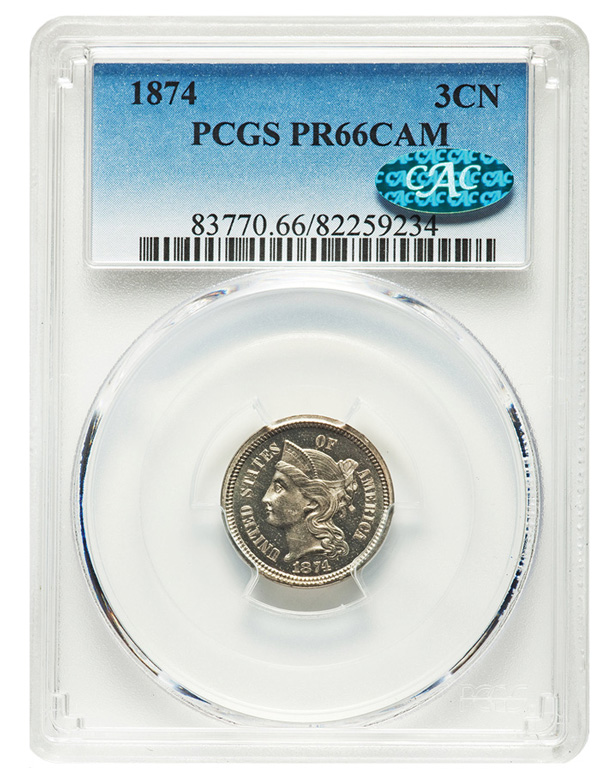
Generally, it is less difficult to find an 1877 than it is to find a Proof
1865. Several CAC approved Proof 1877 Three Cent Nickels have been offered
so far in 2021.
On April 22, 2021, Heritage auctioned a CAC approved, NGC certified Proof-65 1877 for $3,000 even. In 2021, Stack’s Bower’s auctioned two different CAC approved, PCGS certified Proof-66 Cameo 1877 Three Cent Nickels, the first for $3,600 on March 25 and the second for $3,120 on June 10.
If a Proof coin has noticeable Cameo contrast, but has not received a Cameo designation, then it would be unsurprising if a wholesaler resubmits it to PCGS or NGC with the goal of receiving a Cameo designation. In other words, if a Proof Three Cent Nickel was graded by PCGS or NGC and did not have receive a cameo designation, a wholesaler may submit the same coin again, sometimes after dipping it in an acidic solution, if he thinks that there is a financially meaningful chance that it will receive a Cameo designation.
Many Proof coins developed a sharper Cameo contrast after having been dipped in an acidic solution. Personally, I usually prefer the appearance of such coins before they were dipped. Colorful natural toning and cool clouds are often destroyed by dipping.
A certified Proof without a Cameo designation that received a green sticker from CAC will not necessarily receive a sticker again if it is later designated as Cameo by PCGS or NGC, though some will be stickered a second time. There are wholesalers who kept the PCGS and NGC printed labels that were inside the holders that they cracked open. Invariably, there are some individual coins, especially Cameo designated Proof coins that have been stickered more than once at CAC and are listed more than once in CAC population data. An immediate point is that PCGS, NGC and CAC population data may overstate the number of Proof Three Cent Nickels that have been certified, especially since coins with Cameo or Deep Cameo designations may have previously been certified without such a designation.
In my opinion, it is not a good idea to pay a substantial premium solely because a coin has a Cameo designation. If a collector sees the respective coin and is spellbound by its Cameo contrast, then it may make sense for that particular collector to pay a large premium for that specific coin. In many cases, however, there are subtle differences between Proofs of the same type and date that have received Cameo designations and those that did not. A coin that did not receive a Cameo designation may later receive one from the same grading service. Collectors should focus on the characteristics of an individual coin and then reflect upon its certification, rather than buy the holder and just casually glance at the coin.
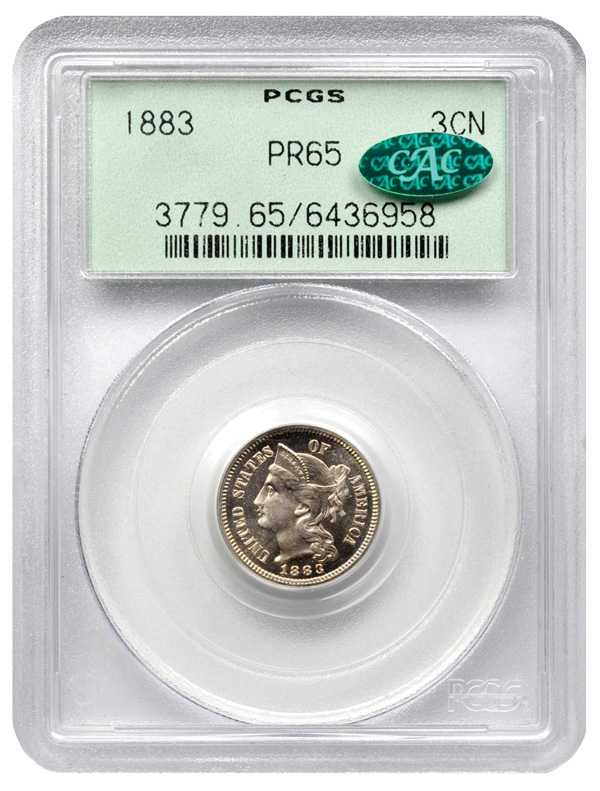 While the importance of a Cameo contrast is a matter of personal
preference, it is sensible to think about the extent of the contrast in
particular instances, about the visual appeal of Cameo contrasts, and about
the logic of premiums for Cameo designations. A CAC approved Proof-66 1874
has a CPG®-CAC estimated retail value of $972, and the CPG ®-CAC retail estimate for a Proof-66 1874 with a Cameo
designation is $1,050, just $78 more, about an 8% premium. This is a small
premium; it certainly would not be alarming to pay an additional $78 for a
CAC approved Proof-66 Cameo 1874 Three Cent Nickel, regardless of the
extent or desirability of the respective Cameo contrast.
While the importance of a Cameo contrast is a matter of personal
preference, it is sensible to think about the extent of the contrast in
particular instances, about the visual appeal of Cameo contrasts, and about
the logic of premiums for Cameo designations. A CAC approved Proof-66 1874
has a CPG®-CAC estimated retail value of $972, and the CPG ®-CAC retail estimate for a Proof-66 1874 with a Cameo
designation is $1,050, just $78 more, about an 8% premium. This is a small
premium; it certainly would not be alarming to pay an additional $78 for a
CAC approved Proof-66 Cameo 1874 Three Cent Nickel, regardless of the
extent or desirability of the respective Cameo contrast.
For CAC approved Proof-66 1881 Three Cent Nickels, the CPG®-CAC retail value estimate are $715 for a coin without a designation, $789 with a Cameo designation, and $1,580 for an 1881 with a Deep Cameo or Ultra Cameo designation. I would not suggest paying $1,580 for an 1881 Three Cent Nickel. Moreover, for a Proof-67 1881, the CPG®-CAC estimates are $1,180 for a coin without a designation, $1,270 with a Cameo designation, and $11,200 for a Proof-67 1881 with a Deep Cameo or Ultra Cameo designation. Does it make sense to pay more than eight times as much for a Deep or Ultra Cameo designation as the same coin would cost without such a designation?
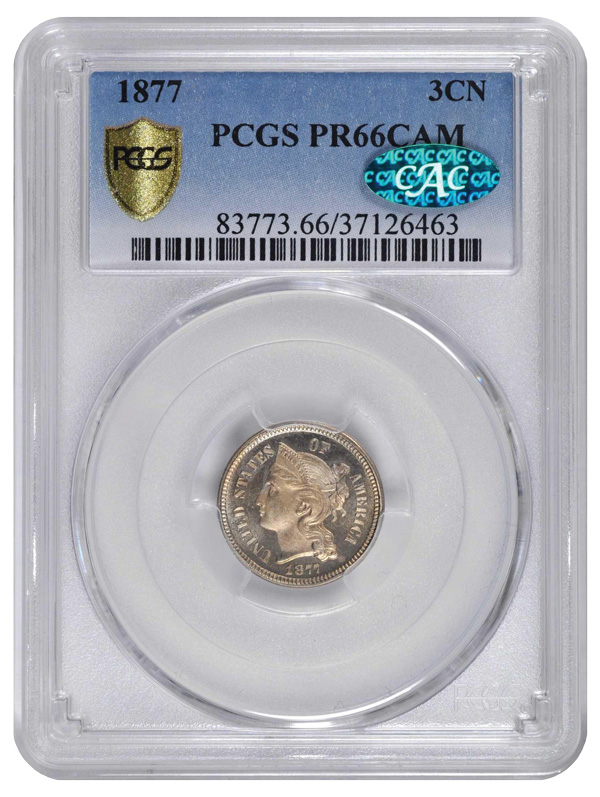 It is not just the Deep Cameo and Ultra Cameo designations that bring giant
premiums. The CPG®-CAC retail price estimate for a Proof-66 1887
is $785 and the corresponding estimate for a Proof-66 Cameo 1887 is $1,440.
In my view, it usually is not a good idea to pay an 80% premium for a Cameo
designation.
It is not just the Deep Cameo and Ultra Cameo designations that bring giant
premiums. The CPG®-CAC retail price estimate for a Proof-66 1887
is $785 and the corresponding estimate for a Proof-66 Cameo 1887 is $1,440.
In my view, it usually is not a good idea to pay an 80% premium for a Cameo
designation.
Many non-cameo, Proof Three Cent Nickels feature appealing blue and russet toning, sometimes with wonderful green tints. Moreover, some of the non-cameo Proofs with russet and gray tones over vibrant mirror surfaces are exceptional. In my opinion, very attractive natural toning, especially toning that is likely to have stemmed from original mint packaging, is more desirable than a Cameo contrast.
Regardless of whether they have Cameo contrasts, CAC approved Proof 1874 Three Cent Nickels are relatively scarce, though market levels do not completely reflect their relative scarcity. Back on Dec. 1, 2020, Heritage sold a CAC approved, Proof-66 Cameo 1874 for just $810 and a CAC approved Proof-65 1874 Three Cent Nickel for $420. In the context of 19th century Proof U.S. coins, these are not large amounts.
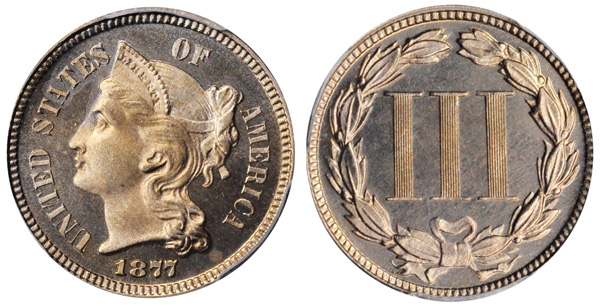
The 1872 is even more of a CAC scarcity than the Proof 1874 Three Cent
Nickel. In total, just seventy-nine Proof 1872 Three Cent Nickels have been
approved by CAC, yet this is not one of the more expensive dates in the
series. On June 15, 2021, Heritage sold a CAC approved Proof-66 1872 for
$720.
Although it may take time to find representatives of a few of the relatively scarce dates, a CAC-only set of Proof Three Cent Nickel is a very practical objective. Only a few dates are particularly expensive. Many can be purchased for prices in the range of $350 to $800 each. For a complete CAC-only set of Proofs of a whole 19th century denomination, the costs of Proof Three Cent Nickels are low in the grand scheme of classic U.S. coins.
Copyright ©2021 Greg Reynolds
Insightful10@gmail.com

Download the Greysheet app for access to pricing, news, events and your subscriptions.
Subscribe Now.
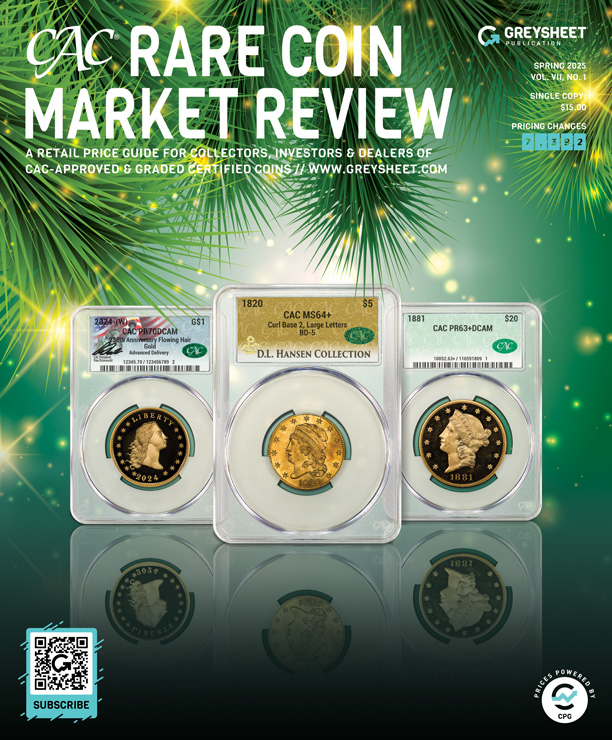
Subscribe to CAC Rare Coin Market Review for the industry's most respected pricing and to read more articles just like this.
Source: Greg Reynolds
Related Stories (powered by Greysheet News)
View all news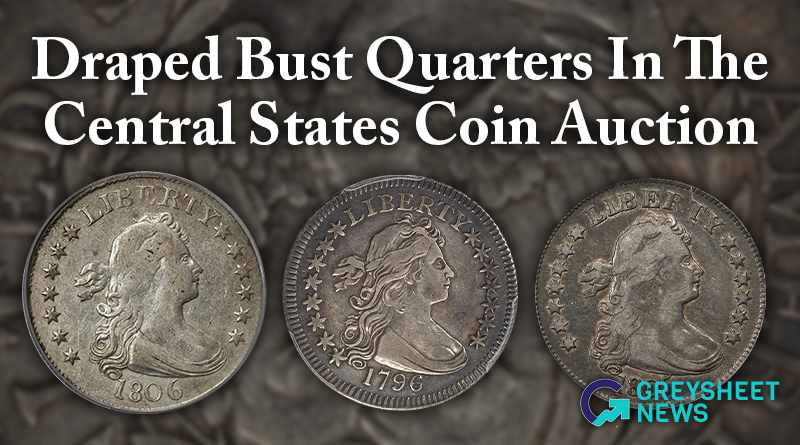
The Lusk set of Draped Bust quarters brought strong results.
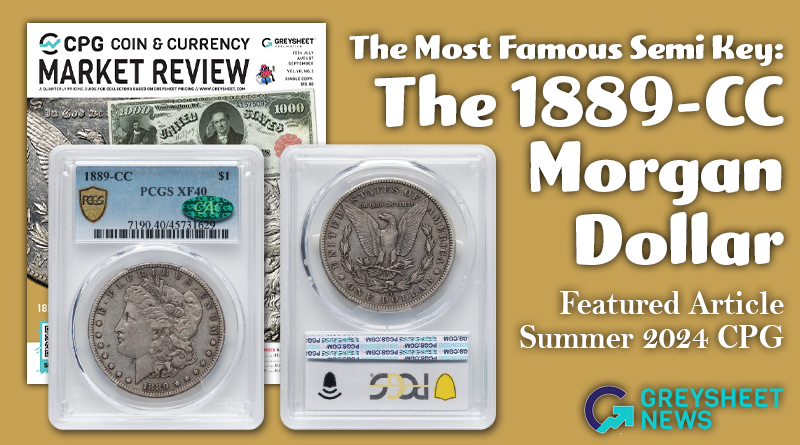
The 1889-CC is the second scarcest business strike in the series.
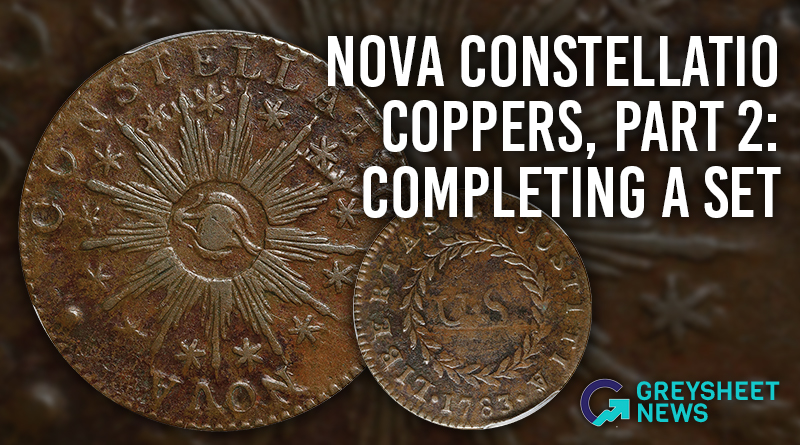
Just six coins are required for a set of true Nova Constellatio Coppers, and the coins selected need not be very expensive.


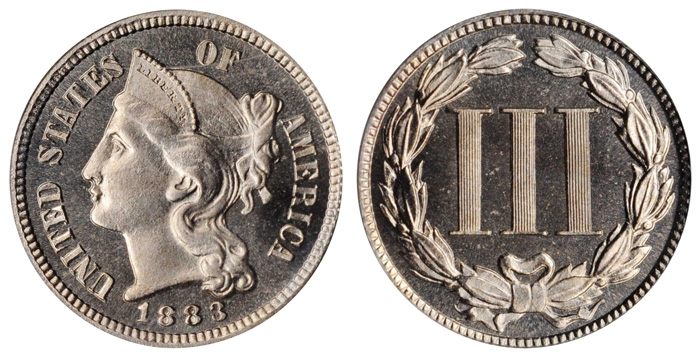






Please sign in or register to leave a comment.
Your identity will be restricted to first name/last initial, or a user ID you create.
Comment
Comments